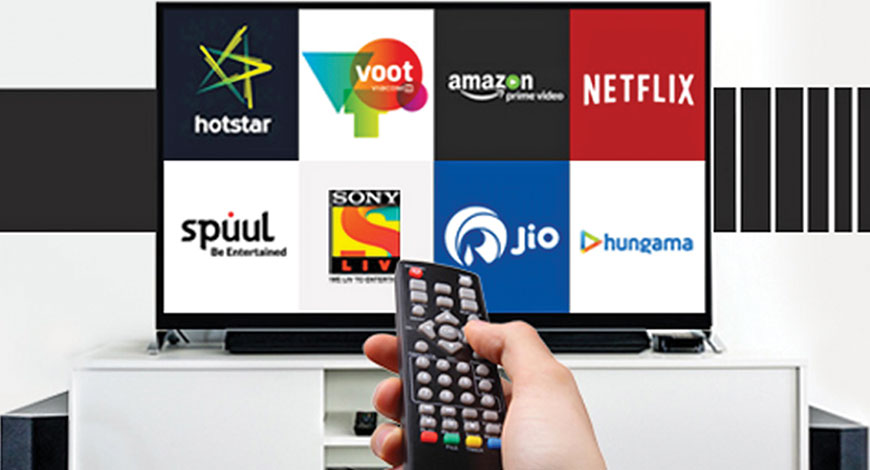Cloud
From streaming wars to streaming skirmishes

The streaming wars are kicking off and in an era of golden storytelling, audiences have a smorgasbord of choice when it comes to content with more platform options than ever before. The video-media landscape is being reshaped, with over-the-top (OTT) video-streaming providers and mobile network operators (MNOs) collaborating to decode the complex behavioral and consumption patterns of the modern-day online video-content users. OTT video-streaming platforms are coming out with new and innovative product offerings that can enhance customer engagement and expand their subscriber base. OTT content providers seem to be in a hurry to exploit new opportunities as more people switch to online channels by cord-cutting. Changing consumer video-viewing habits are forcing the media industry to evolve. Broadcasters, content owners, and pay-TV providers are all looking at new business models, new technologies, and hybrid strategies in an effort to stay ahead of OTT disruption.
Race to one billion
Subscriptions to SVoD services will increase by 439 million between 2018 and 2024 to reach 947 million globally, with the total climbing by 119 million in 2019 alone, according to Digital TV Research. It is estimated that SVoD subs will reach nearly one billion within the next five years with the US and China leading the charge.
By 2024, it is estimated that Netflix will contribute 203 million subscribers or 21 percent of the global total, with Amazon Prime Video’s 125 million accounting for 13 percent and Disney+ on 75 million, while 255 million will subscribe to a variety of other available services.
Leveraging multi-screen use
Paid-TV streaming services have certainly gained momentum in 2019, and while the trend may be draining advertising revenues, ads can survive if they know how to ride the wave. They are stepping up and listening to consumers carefully. Agencies and their brands are being nimble and able to adapt to this evolving OTT landscape. This means redistributing ad budgets toward sponsorship and advertiser-funded programming, second screen campaigns on social and other awareness mediums that align with a digital model, such as out-of-home and audio.
Brands need to be reassured and reminded of society’s penchant for multiple screens and digital devices, and this needs to be leveraged moving forward. Brands also need to ensure they are hitting the bull’s eye with their messaging and campaigns by taking advantage of data-driven audience insights. If brands can keep up with how modern audiences consume media, they will be well placed to succeed in 2020.
The latest OTT players
In November 2019, Disney launched its subscription Disney+ service, and offers a hybrid bundle of Disney+, Hulu, and ESPN+. Apple TV+ has brought its own long-anticipated subscription service into the market at the same time. AT&T, meanwhile, is expanding its AT&T TV, AT&T TV Now, and AT&T WatchTV services, while planning a spring 2020 deployment of four more services under the HBO brand. NBCUniversal is also set to come to market in 2020, and the list goes on.
Broadcasters, studios, pay-TV operators, sports leagues, and various content-rights holders are all looking to go over-the-top directly to consumers (D2C), cutting out the middleman. A D2C play also allows them to create multiple flavors of their services – a la Disney and AT&T – creating multiple incremental revenue streams that allow them to appeal to not only broad swaths of consumers, but to very specific groups, as well.
Media companies are also offering consumers options on how they pay for content. While SVoD has been the fastest-growing business model, ad-supported services are seeing new traction as consumers look to limit spending on subscriptions. The result has been more OTT providers looking to offer hybrid models – a combination of SVoD, AVoD, and freemium.

David Sidebottom Principal Analyst, Futuresource
“We have seen the subscription video-on-demand sector enter a new era in 2019, with the rise of new-wave D2C services. Scale will be key in the D2C space, but clearly the coming year is just the first phase in this era. D2C services will likely evolve, with their parent companies continuing to evaluate the benefits of D2C versus third-party agreements. This will be particularly the case as services expand on an international basis, where legacy agreements, existing scale distribution partners, and differing levels of SVOD uptake will be factors in their evolving D2C strategy.”
The monetization issue
The new entrants are strong on paper, but there are big questions hanging over the potential growth of the sector. Do audiences want endless services and, perhaps more pertinent, will they pay?
Netflix has done a great job establishing itself as the leader in the market, but more and more content and media owners have said they will pull their content from its offering in a move to lure audiences and revenue streams back to these new services. This is certainly true for the likes of Friends, The Office, and Fresh Prince of Bel Air to name a few, with more no doubt likely to follow. What does the entrance of new players in the global streaming video-on-demand (SVoD) landscape mean for the established players?
Disney owns some of the most popular and valuable content in the entertainment world, which gives it a major advantage over its rivals but how deep are consumers’ pockets? The key is content and with Disney’s service boasting more than 500 movies and 7500 episodes of current and past TV programs, it does not quite match Netflix’s catalog of 4000 movies and 47,000 TV shows, so it has bet on audiences trading in Netflix for their favorite franchises.
To co-exist or compete?
Netflix chief executive Reed Hastings is confident about the burgeoning streaming landscape and increased competition. According to Hastings, Netflix competes so broadly with all of these different providers that any one provider entering only makes a difference on the margin. Warner Media has not yet set a timetable for an international roll-out and has confirmed it will continue to sell international streaming rights to its programming; Apple made its service available in 100 countries within months of its US launch. Disney on the other hand has not revealed specific details but hinted to an international roll out of Hulu and would be likely to leverage international assets, namely, Star India network, which it acquired in the acquisition of Fox.
The streaming wars to date have mainly bounced around the US, UK, and European markets; however, the global imprint is growing rapidly with China overtaking the US and India overtaking China in most recent news. Leading services are expected to have little overlap with each other in terms of content, so services such as HBO Max, Apple TV+, and Disney+ will be looking to complement the likes of Netflix, rather than go head to head. However, new services and D2C offerings lead to fragmentation; multiple SVoD service uptake amongst users is set to rise, trending toward an average of three in leading markets such as USA. Therefore, consumers will be looking for pan-service search, navigation, and UI to help provide a seamless users’ experience amongst the clutter of SVoD services.
Going hybrid is a win-win
If 2019 was the year of the streaming war, 2020 may be the year of streaming skirmishes. With several new platforms now having been launched, it is now a case of jostling for market share and keeping users interested beyond the big glitzy launches. After all, competition is fierce, and consumers simply do not want to keep forking out for subscriptions in order to watch their favorite programs. That does not mean the appetite for content is not there, but the appetite for endless subscriptions is not.
Ad-funded models are expected to be the answer to providing consumers with the content they want in 2020, without demanding more cash from them. That is good for consumers, and it also offers streaming platforms a way to stand out in what is an ever-growing, and now very crowded, market.
There are wider benefits to these hybrid and ad-funded models, too. Ads can be a real plus for viewers. What is more, engagement on streaming platforms is significantly higher than elsewhere. In essence, going hybrid is a win-win for consumers, broadcasters, and brands alike – funding better content, expanding reach, and offering reliable, brand-safe, and privacy-compliant access to consumers.
Spotlight on India
India’s online video subscriber base is forecast to reach 500 million by 2023, making it the second-biggest market after China, according to a report by KPMG and Eros Now. The increasing internet penetration and access to digital infrastructure across India make it an important market for the OTT industry. Varied and innovative content offerings with superlative services will let OTT platforms cater to the growing market. With the number of subscription OTT video viewers continuing to rise with more and more room to grow, the landscape is likely to become even more crowded.
SVoD users in 2019 saw an increase of 7 percent over 2018, according to eMarketer. Forecasts put the number at just over 197 million users by 2021, an 8 percent increase over this year.
It is more than likely that the number of subscriptions per service will be reported less and the actual viewing numbers will be what media companies begin shouting about. Nonetheless, the landscape is crowded and growing while the demand for audiences is ever-present.

Simon Murray Principal Analyst, Digital TV Research
“China overtook the US in 2018 to become the gross SVoD subscription leader. These two countries will continue to dominate the world stage. China and the US will together account for 59 percent of the global total by 2024. However, this proportion is down from 63 percent in 2018, indicating that other countries are growing faster.”
Online video landscape in India
India’s online video market is potentially one of the most exciting markets and businesses in the world. It is estimated that India will have more than 500 million online video subscribers by 2023, and this would make it the second-biggest market in the world behind China alone.
As India witnesses the change in the definition of mass general entertainment, movies, and sports are likely to be driver content, and digital original series would likely be an important tool in defining this transition in culture. A déjà vu of what India saw in the early days of cable television, this universe is going to be divided into the bundled and the a-la-carte model, with telcos/internet service providers (ISPs)/network partners, original equipment manufacturers (OEMs), broadcasters, movie studios, and technology aggregator platforms all playing a key role in the development of this universe of audiences. India will continue to be a challenging market in terms of audience pivots on language, content genres, access, and several million consumer cohorts to truly exploit the mid to long tail of online video.
There is a significant probability that in Tier-III+ markets in India, consumers are expected to experience the internet for the first time, with online video hence making it a gateway tool for a true Digital India. OTT players across the board have been focusing on developing a robust distribution strategy to have a widespread presence across their target audiences and across various device ecosystems. Thus, alliances with telecom operators, cable TV/DTH operators, OEMs, and others are being actively forged to ensure an optimum distribution depth.
Content partnerships with telecom companies have emerged as the preferred distribution channels for OTT players. Such partnerships not only help to expand the reach but also help boost subscription income for these players. Various OTT players have partnered with DTH operators through integration of apps into the set-top boxes, allowing the user to access the services with a dedicated remote button. Services like Tata Sky Binge provide the user with a dedicated hardware to access the OTT apps on their television sets, irrespective of whether the TV has a smart functionality or not. OTT players have partnered with different hardware manufacturers including smartphones, smart TVs, streaming devices, and gaming consoles, among others, to allow users to easily access these apps on their preferred devices. Some players have also forged partnerships among themselves to mutually benefit and leverage each other’s strength. For example, Zee5 and Alt Balaji have forged a content-sharing arrangement to co-create original content in Hindi, which will be available exclusively on both the platforms.
Traditional content categories have dominated consumption preferences on online video platforms. While platforms have been investing heavily in creation of original content designed for digital audiences, library content still dictates current consumption trends. This could potentially be due to the limited supply of originals (less than 1 percent of overall content available on most broadcaster-driven and global platforms) in contrast to library content that forms a bulk of the content available on online video platforms.
With the internet and smartphone penetration in India reaching a critical mass, access to OTT platforms has become widespread across different cultures, regions, and languages. In order to cater to this wide audience base, platforms have been increasingly providing personalized content and experiences. One of the important aspects of this personalization, where the platforms have been investing heavily, is content creation in different Indian languages.
Currently, global platforms like Netflix and Amazon Prime Video have a large library of English originals, comparatively smaller library of Hindi content, and a minimal presence in terms of regional content. However, India-specific platforms have a specific focus on Indian languages. While Hindi dominates at an overall level, content preferences across other major language speakers such as Gujarati, Telugu, Bengali, and Marathi have skewed toward their native language. This points to a large opportunity, waiting to be explored, for the online video players in terms of content creation and micro-targeting the demand that emanates from across the country.
Way forward
It is entirely up to OTT platform players on how they align their businesses in synchronization with the maturing markets. OTT streaming platforms will have to refurbish their user acquisition (UA) strategies, from running cost-per-install (CPI) campaigns to providing free-trial subscriptions, as differentiator for staying ahead of the curve. 2020 is set to be a hugely important year in the world of OTT as the wave of new streaming services continues. Disney+ will roll out around the rest of the world, while several new major media companies will follow suit with their own platforms, giving customers more choice than ever before, but also higher costs than ever before.
In 2020, the industry will see the impact of the streaming wars with new services continuing to enter the market. However, this fragmentation should not be viewed as a challenge, but rather a prime opportunity for advertisers to extend the reach of their campaigns. Ad-support streaming platforms will increasingly be used by advertisers to complement linear, acting as reach extenders that allow brands to engage with audiences that they would not reach with linear alone. The potential to then optimize these multi-channel campaigns will be huge.
Although OTT platforms currently attract only 3 percent of TV media budgets, advertisers can reach 29 percent of viewers through streaming. The year 2020 will see brands jump on this opportunity in force. Optimizing streaming was in its infancy in 2019, but 2020 will see it evolve into the new norm. OTT will become a fully measurable, scalable, and accountable part of advertisers’ media mixes, enabling greater reach and RoI as a result.






You must be logged in to post a comment Login